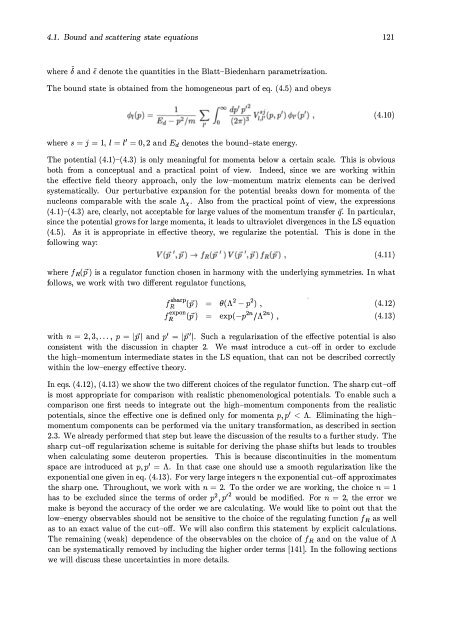The Nucleon-Nucleon Interaction in a Chiral Effective Field Theory
The Nucleon-Nucleon Interaction in a Chiral Effective Field Theory
The Nucleon-Nucleon Interaction in a Chiral Effective Field Theory
You also want an ePaper? Increase the reach of your titles
YUMPU automatically turns print PDFs into web optimized ePapers that Google loves.
4.1. Bound and scatter<strong>in</strong>g state equations 121<br />
where J and E denote the quantities <strong>in</strong> the Blatt-Biedenharn parametrization.<br />
<strong>The</strong> bound state is obta<strong>in</strong>ed from the homogeneous part of eq. (4.5) and obeys<br />
where s = j = 1, [ = [' = 0,2 and Ed denotes the bound-state energy.<br />
( 4.10)<br />
<strong>The</strong> potential (4.1)-(4.3) is only mean<strong>in</strong>gful for momenta below a certa<strong>in</strong> scale. This is obvious<br />
both from a conceptual and a practical po<strong>in</strong>t of view. Indeed, s<strong>in</strong>ce we are work<strong>in</strong>g with<strong>in</strong><br />
the effective field theory approach, only the low-momentum matrix elements can be derived<br />
systematicaHy. Our perturbative expansion far the potential breaks down for momenta of the<br />
nucleons comparable with the scale Ax. Also from the practical po<strong>in</strong>t of view, the expressions<br />
(4.1)-(4.3) are, clearly, not acceptable for large values of the moment um transfer q. In particular,<br />
s<strong>in</strong>ce the potential grows for large momenta, it leads to ultraviolet divergences <strong>in</strong> the LS equation<br />
(4.5). As it is appropriate <strong>in</strong> effective theory, we regularize the potential. This is done <strong>in</strong> the<br />
follow<strong>in</strong>g way:<br />
(4.11)<br />
where fR(iJ) is a regulator function chosen <strong>in</strong> harmony with the underly<strong>in</strong>g symmetries. In what<br />
follows, we work with two different regulator functions,<br />
ftarp(p)<br />
f �xpon (p)<br />
B(A2 _ p2) ,<br />
exp( _p2n / A 2n) ,<br />
( 4.12)<br />
(4.13)<br />
with n = 2,3, ... , p = Ipl and p' = Ip'l. Such a regularization of the effective potential is also<br />
consistent with the discussion <strong>in</strong> chapter 2. We must <strong>in</strong>troduce a cut-off <strong>in</strong> order to exclude<br />
the high-momentum <strong>in</strong>termediate states <strong>in</strong> the LS equation, that can not be described correctly<br />
with<strong>in</strong> the low-energy effective theory.<br />
In eqs. (4.12), (4.13) we show the two different choices of the regulator function. <strong>The</strong> sharp cut-off<br />
is most appropriate for comparison with realistic phenomenological potentials. To enable such a<br />
comparison one first needs to <strong>in</strong>tegrate out the high-momentum components from the realistic<br />
potentials, s<strong>in</strong>ce the effective one is def<strong>in</strong>ed only for momenta p, p' < A. Elim<strong>in</strong>at<strong>in</strong>g the highmoment<br />
um components can be performed via the unitary transformation, as described <strong>in</strong> section<br />
2.3. We already performed that step but leave the discussion of the results to a furt her study. <strong>The</strong><br />
sharp cut-off regularization scheme is suitable for deriv<strong>in</strong>g the phase shifts but leads to troubles<br />
when calculat<strong>in</strong>g some deuteron properties. This is because discont<strong>in</strong>uities <strong>in</strong> the moment um<br />
space are <strong>in</strong>troduced at p, p' = A. In that case one should use a smooth regularization like the<br />
exponential one given <strong>in</strong> eq. (4.13). For very large <strong>in</strong>tegers n the exponential cut-off approximates<br />
the sharp one. Throughout, we work with n = 2. To the order we are work<strong>in</strong>g, the choice n = 1<br />
has to be excluded s<strong>in</strong>ce the terms of order p2,p /2 would be modified. For n = 2, the error we<br />
make is beyond the accuracy of the order we are calculat<strong>in</strong>g. We would like to po<strong>in</strong>t out that the<br />
low-energy observables should not be sensitive to the choice of the regulat<strong>in</strong>g function fR as weH<br />
as to an exact value of the cut-off. We will also confirm this statement by explicit calculations.<br />
<strong>The</strong> rema<strong>in</strong><strong>in</strong>g (weak) dependence of the observables on the choice of fR and on the value of A<br />
can be systematically removed by <strong>in</strong>clud<strong>in</strong>g the higher order terms [141]. In the follow<strong>in</strong>g seetions<br />
we will discuss these uncerta<strong>in</strong>ties <strong>in</strong> more details.












